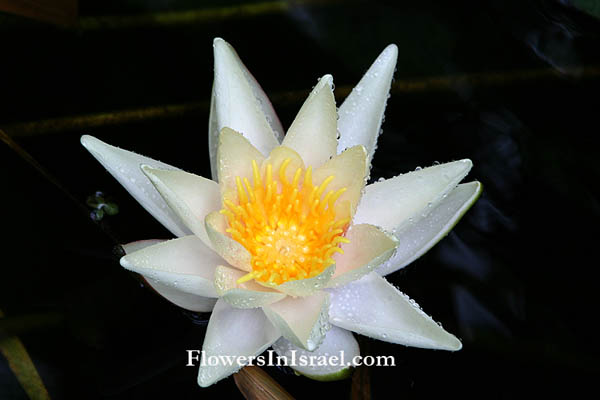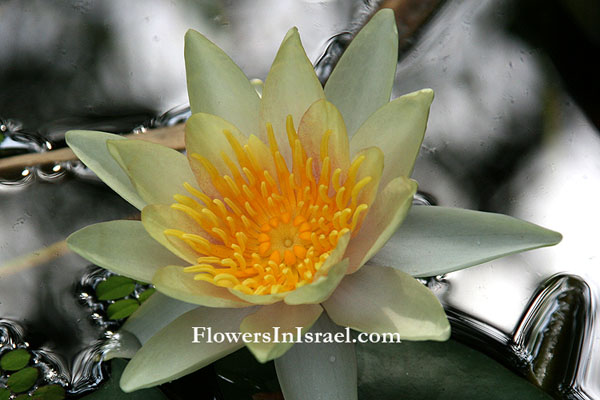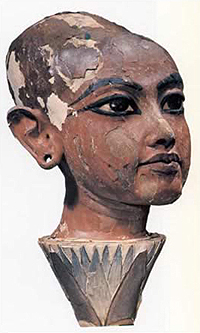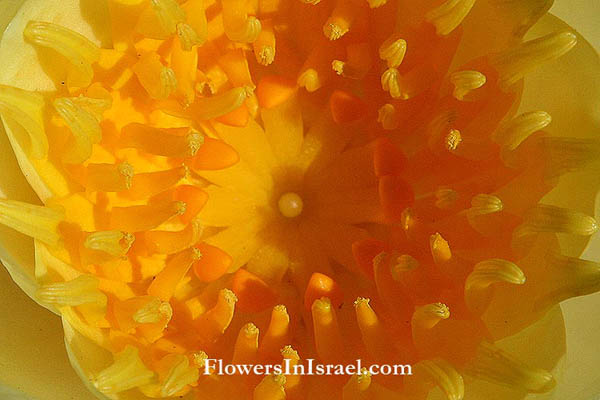Hebrew: נימפאה לבנה, Arabic: زنبق الماء
| Scientific name: | Nymphaea alba L. | |
| Common name: | White Water-Lily | |
| Hebrew name: | נימפאה לבנה | |
| Arabic name: | زنبق الماء | |
| Family: | Nymphaeaceae, נופריים |

|
| Life form: | Geophyte | |
| Stems: | In water from 30-150 cm deep; stems of Nymphaea alba differed significantly between the two seasons, with higher values obtained in the spring | |
| Leaves: | Rosette, up to 30x25 cm,entire | |
| Inflorescence: | Flowers emerge on separate stem stalks; solitary, hermaphrodite | |
| Flowers: | White; flower 10-20 cm in diameter; receptacle cylindrical; petals 20-25, stigma with 14-20 rays | |
| Fruits / pods: | Large quantities smooth, olive-green seeds | |
| Flowering Period: | May, June, July | |
| Habitat: | Humid habitats | |
| Distribution: | Mediterranean Woodlands and Shrublands | |
| Chorotype: | Med - Euro-Siberian | |
| Summer shedding: | Perennating |

Derivation of the botanical name: Nymphaea, from the Greek term "Νυμφαία", possibly related to "Νύμφη" meaning "nymph". The nymphs in Greek and Roman mythology were supernatural feminine, attractive and playful water nymphs of the same habitat. alba, "white". The Hebrew name: נימפאה, Nymphaea, from Latin: nympha (=nympha), from Greek: nymphe; transliteration from the scientific name. Lotus is the classical name of various plants, there are:

Nymphaea is a genus of aquatic perennial plants having showy flowers (white, blue, pink, or yellow, often fragrant), including the white water lily and the Egyptian lotus. Linnaeus (1753) originally described the genus Nymphaea L. to include three entities: the yellow water-lilies (currently Nuphar), white water-lilies (currently Nymphaea), and water-lotuses (currently Nelumbo Adans.). They are growing from an underwater stem, which is buried in the mud and sends down rootlets for anchorage. The rhizome of the Nymphaea is astringent and antiseptic. It contains alkaloids (nymphaeine and nupharine), resin, glycosides, and tannins. Israel was a meeting point of the southernmost border of distribution for the white water lily (Nymphaea alba) and the northernmost limit for the blue water lily (Nymphaea caerulea). In 1999, a nursery of aquatic ornamental plants was founded in the framework of the Jewish National Found (KKL) nursery and Nymphaea caerulea and Nymphaea alba were included in the nursery program. According to the ancient Greeks, the water lily was originally a Nymph, Lotis, a female spirit of nature, who was transformed into a lotus while fleeing from the phallic deity Priapus, a minor rustic fertility god of purely phallic character. That is how these beautiful flowers came to be. Ovid (Publius Ovidius Naso, 43 BCE – 17CE), a Roman poet, twice recounted an anecdote of Priapus’s foiled attempt on a sleeping nymph: once he told it of the nymph Lotis and then again, calling it a “very playful little tale”, he retold it of Vesta, the Roman equivalent of Hestia. In Homer's Odyssey a mythical nation is described where the people subsist entirely on the lotus. Homer (9th or 8th century BCE)- The Odyssey, (Translated by Samuel Butler 1900), Book IX …"I was driven thence by foul winds for a space of nine days upon the sea, but on the tenth day we reached the land of the Lotus-eaters, who live on a food that comes from a kind of flower. Here we landed to take in fresh water, and our crews got their mid-day meal on the shore near the ships. When they had eaten and drunk I sent two of my company to see what manner of men the people of the place might be, and they had a third man under them. They started at once, and went about among the Lotus-eaters, who did them no hurt, but gave them to eat of the lotus, which was so delicious that those who ate of it left off caring about home, and did not even want to go back and say what had happened to them, but were for staying and munching lotus with the Lotus-eaters without thinking further of their return; nevertheless, though they wept bitterly I forced them back to the ships and made them fast under the benches. Then I told the rest to go on board at once, lest any of them should taste of the lotus and leave off wanting to get home, so they took their places and smote the grey sea with their oars…" The Nympyhaea caerulea was by far the most important flower in ancient Egypt. The Egyptians saw that the blue water lily opened up each morning and each afternoon would close again only to open again each day. Since Atum was an early solar deity in Egyptian mythology, Nefertum (literally meaning young Atum) represented sunrise, consequently Atum became mainly understood as the setting sun. Since Atum had arisen from the primal waters in the bud of an Egyptian blue water lily (Nymphaea caerulea), Nefertum was associated with this flower.  The Egyptians equated the Creator-god with the Blue Lotus, which is believed to have emerged at some point in time from the primeval ocean. The sun god Re had become into being by appearing from a lotus flower floating on primeval waters, being born from a floral womb. As a symbol of rebirth for the Kemet (one of the indigenous names for “Egypt”), the Lotus was closely related to the imagery of the funerary and Osirian cult. The Four Sons of Horus (a group of four gods) were frequently shown standing on a Blue Lotus in front of Osiris (god of the dead). The use of Nymphaea caerulea and of Nymphaea lotos in rites and rituals is depicted in the frescoes within the tombs, and in very early papyrus scrolls. The most important of these was the scroll of Book of the Dead, a description of the ancient Egyptian conception of the afterlife and a collection of hymns, spells, and instructions to allow the deceased to pass through obstacles in the afterlife. The scroll says, “Rise like Nefertem from the blue water lily, to the nostrils of Re, and come forth upon the horizon each day.” The blue water lily was symbolic of rebirth after death. The Egyptians looked forward to their souls coming to life “like a water lily reopening”, thinking that the deceased died as the water lily closed awaiting opening with the morning sun. In the tomb of Tutankhamun was found a wooden sculpture depicting this very moment. Nymphaeas were used to make the wreaths found on the mummy of Ramses II dating back to 2000BC. It was Dioscorides, who called both kinds of water lily under Nymphaea, called the white kind Nymphaea, and the yellow kind Nuphar. According to legend Clovis I, king of the Franks (482-511), who united Gaul and set up his capital at Paris, chose the lily as the emblem of his purification by baptism when he accepted Christianity (the lily symbolizing purity) The dried flowers of certain species of Nymphaea are sometimes smoked, made into a tea, or macerated in alcohol for a mild sedative effect. Bible Resources:

|